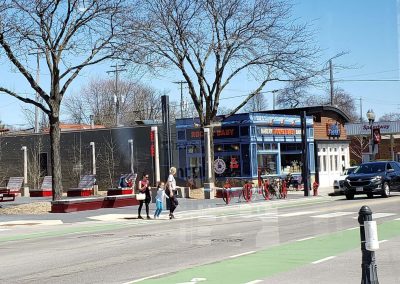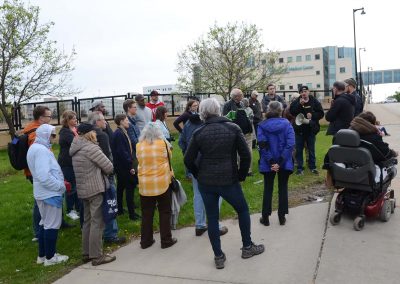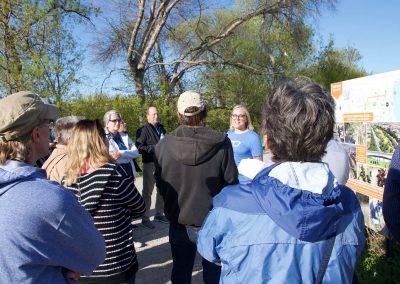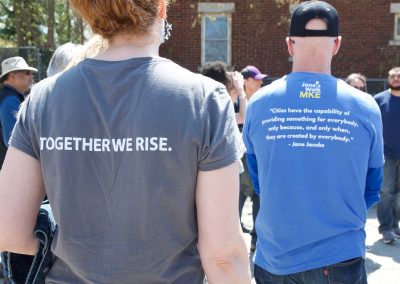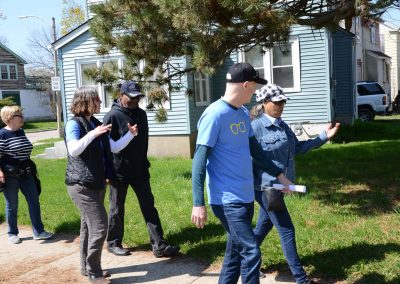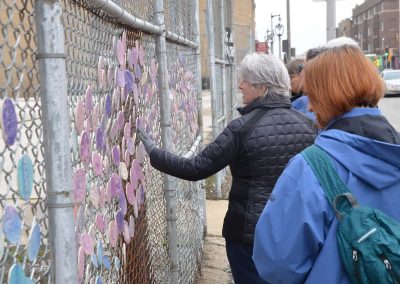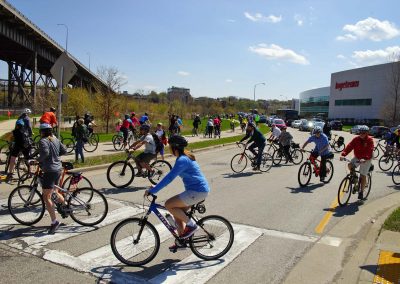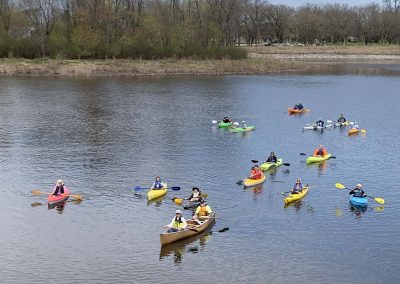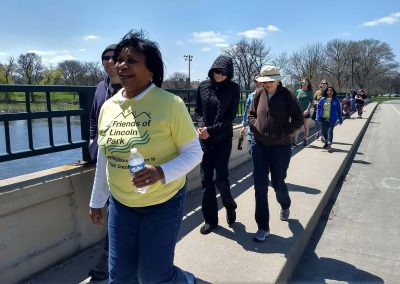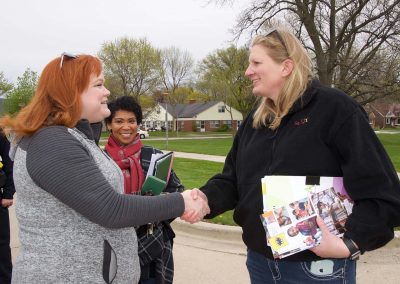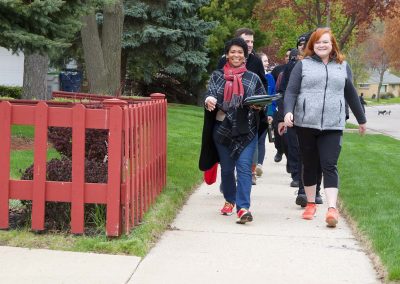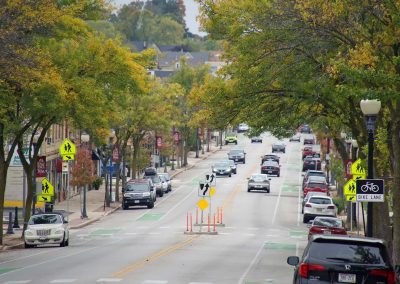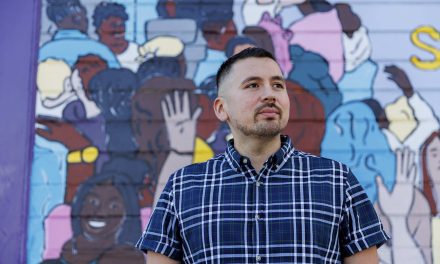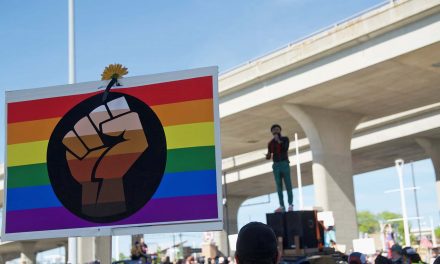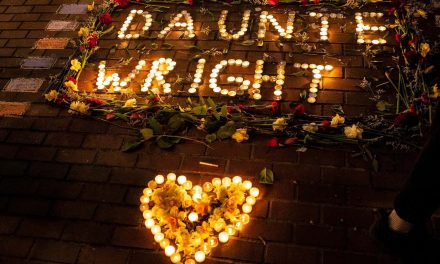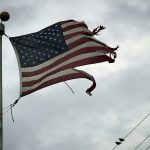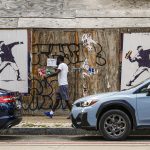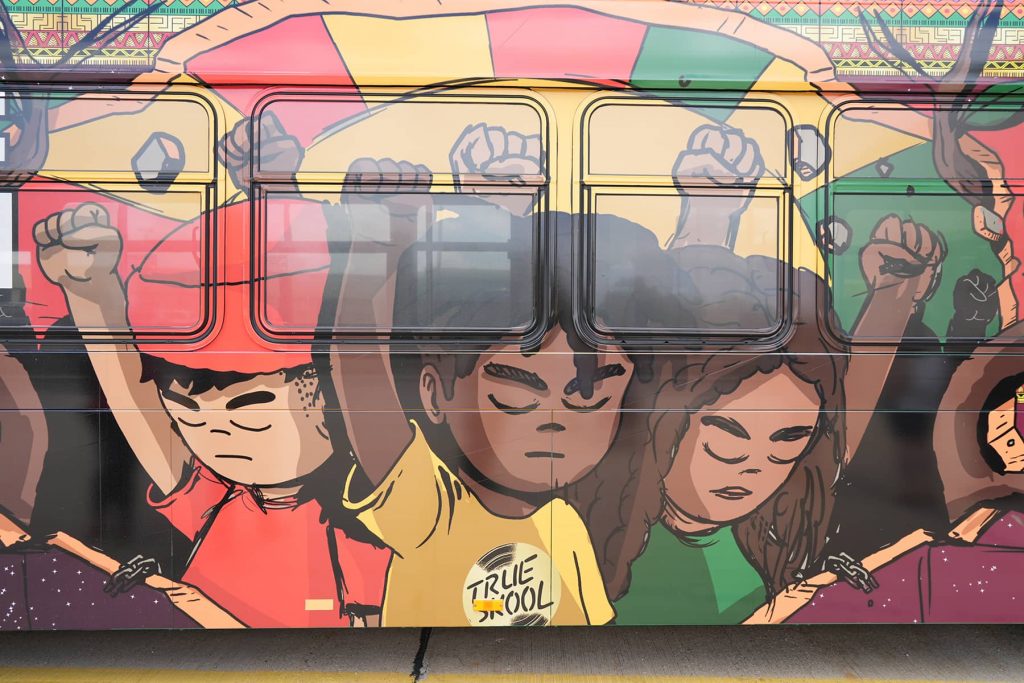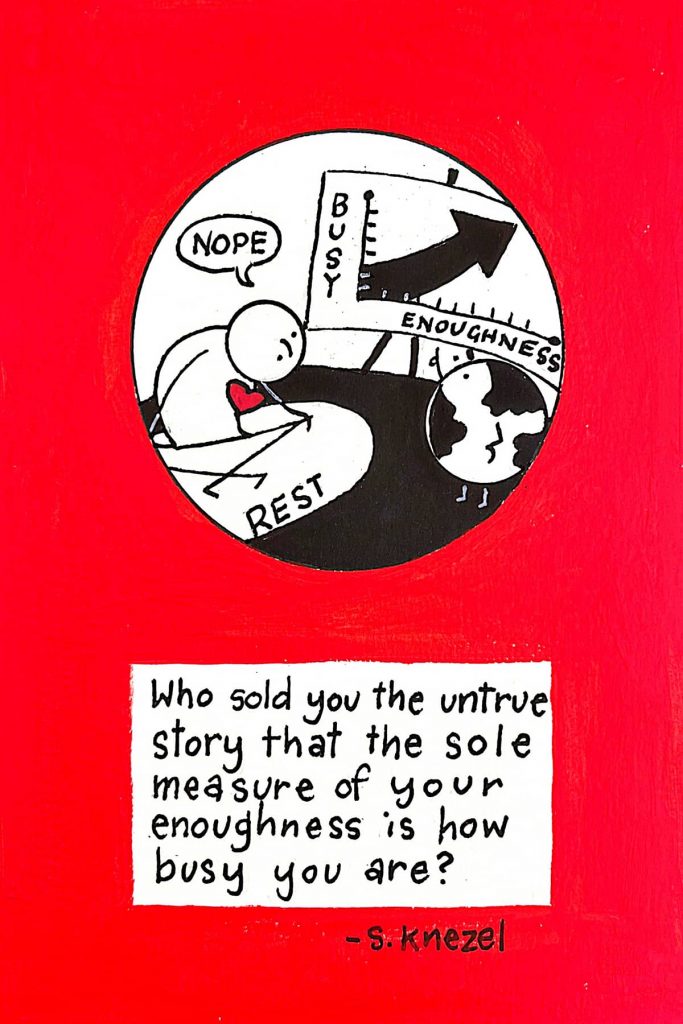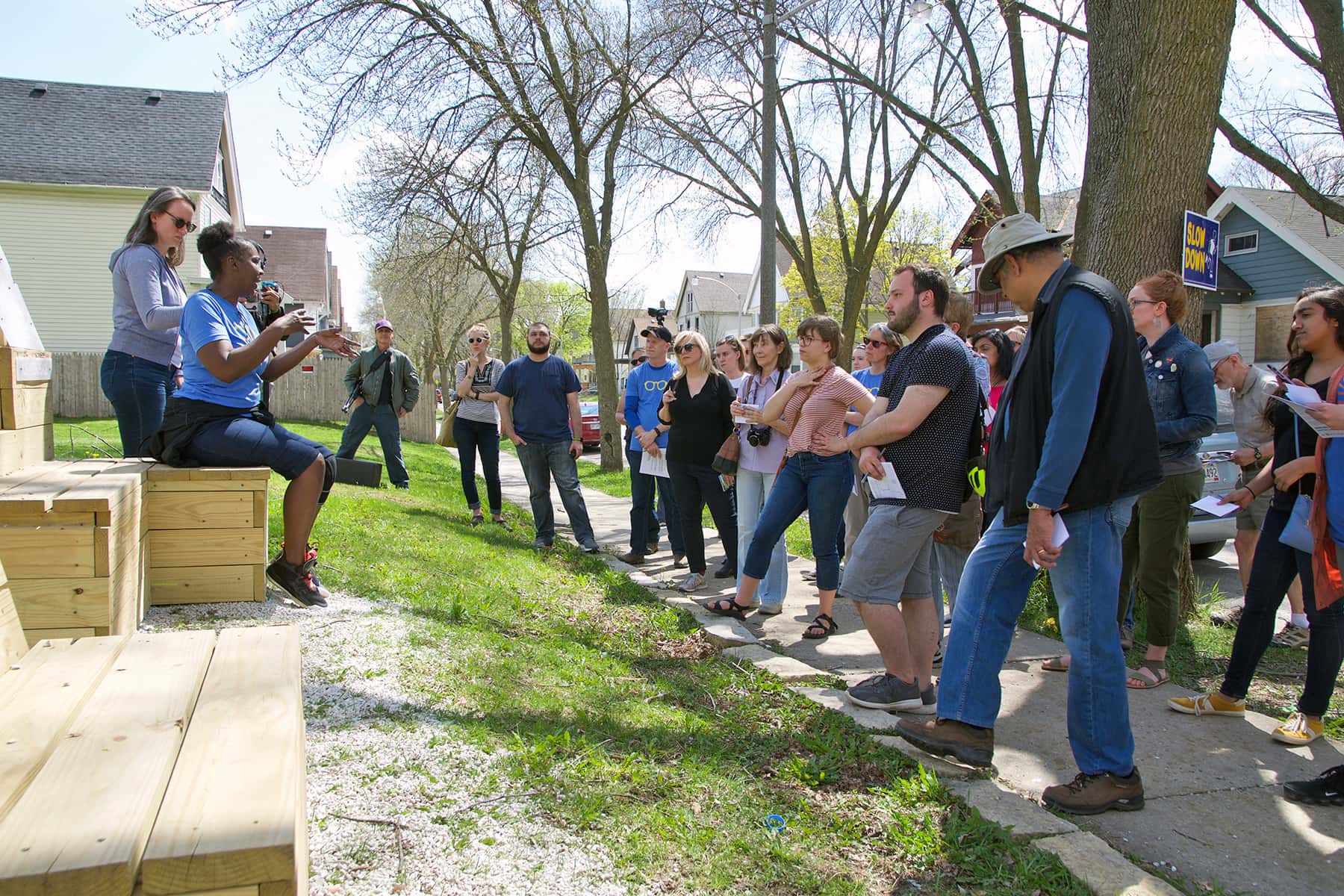
This past April I saw three children huddled at the street corner in front of Camp Bar Tosa, eyeing the other side as if North Avenue was a raging and dangerous river. They hugged each other as they teetered at the curb. I had witnessed many pedestrians standing hesitantly on the curb, allowing car after car to whiz by, but this sight disturbed me. I should have intervened right away, but was distracted with finishing my errands. When I returned a short time later, I saw that two of the youth had made it across the road, leaving the third one shaking by himself. I crossed the street and asked the child if I could help him. He could only whimper a nod as waves of cars continued rolling by.
At the 2018 Jane’s Walk MKE kickoff celebration, we gathered a panel of seven change-makers in the city, including Executive Director of Alice’s Garden, Venice Williams. In my column about the kickoff last year, I recounted how Williams stirred something within me after listening to her speak. She preached to the fairly homogeneous crowd, which she referred to as “the choir,” with a challenge:
“We have the responsibility to show up on street corners, where life literally enters. When was the last time you hung out on a street corner, and not one where most of the people look like you? If we’re going to start really having an impact in multiple areas the city, we have to show up more in places where we never should be or could be or are maybe not invited to. And if you are not invited, invite yourself. Hear the voices that need to be heard.” – Venice Williams
Her message has multiple levels, one of which spoke directly to our human tendency to remain within our comfort zones, but the key words for me here are “show up more,” “life,” and “impact.”
Williams urged us to show up where life is happening – in all corners of our city – and determine how we can make an impact. That is why this year, as the Jane’s Walk MKE organizing committee reconvened to start planning, I proposed a small but significant revision of our mission. We would not just be about “collectively reimagining the places in which we live, work, and play” but also be about “changing” those places for the better.
It would not be enough anymore to simply dream. We would highlight those efforts that were making community hopes a reality and encourage explorations that would evaluate community assets and struggles, then work to sustain and transform them, respectively.
At the time I saw the three huddled children on the Wauwatosa street corner near where I live, I had not yet planned my own walks. The children made me realize that in order to meet the challenge by Williams for myself, I would have to be more than a lively tour guide of enigmatic walks like I was last year. We were Surrealists exploring “the subconscious of the city,” for instance, or Fluxus composers banging percussion instruments on Brady Street. I would need something more real, something to get more eyes on the street to assess the current crosswalk situation and strategize solutions. I would need to start where I live.
I held the boy’s hand as we stepped into the crosswalk, and held my other palm out to halt cars barreling toward us from both directions – so that we could exercise our rights to walk safely in our neighborhood. This all sounds melodramatic – but it was. Soon after, I wrote my Wauwatosa alderperson to see if we could coordinate a crosswalk safety audit of North Avenue as part of Jane’s Walk MKE, sometime in May.
Since last summer, instead of walking my dog on the side streets of Meinecke or Wright, I have chosen to walk him along North Avenue from 66th to 76th, then back again. This meets my gregarious needs – especially on days when the sidewalks are filled with diners, walkers, and bicyclists – and we gain more mileage by crossing back and forth across the marked intersections.
In my personal version of Tosa activism, I wave to and compliment drivers who stop for us. I have been known – yes, people have heard me – to shout a few choice words and flip the bird at inattentive people driving past me at 40 miles per hour when my dog and I are clearly in the crosswalk making ourselves visible. One time, a police car saw me shout and flip off a driver – and proceeded to pull the guy over at the next block. Mission accomplished. But was it enough?
From the large picture windows at Cranky Al’s, where I used to work a few days a week, I had a perfect view of the crosswalks on 69th. I witnessed dozens of individuals and groups wait and wait for cars to stop. Others would run across the street like their lives depended on it, even if cars did stop for them. If I was not behind the counter, I would sometimes leave the store to usher groups of people across the street, who were too afraid to step off the curb.
On other occasions, when cars came to screeching halts, drivers behind them had to brake quickly as well and risked an accident. Some drivers pass stopped cars in the bike lane even when there are pedestrians still crossing. And some cars have gotten so close that I have been able to spank the side of their cars.
It is true that some pedestrians have availed themselves of the little red flags that a Boy Scout placed in buckets at numerous intersections a couple of years ago. They were meant to be held out to signal drivers to slow down and stop. At least that young man took the initiative to make a difference. Unfortunately, the only people I have ever seen use them are brave toddlers “assisting” their families, swinging the flags confidently. Or groups of twenty-something men who think it is hilarious to play “crossing guard.”
Knowing that my personal efforts and interventions would never make a permanent impact, on May 23 I led my crosswalk audit to assess the safety of North Avenue intersections from 60th and 73rd Streets.
We had to start somewhere. I was joined by Alders Heather Kuhl and Joel Tilleson from District 5 and Jason Wilke from District 8, who is also on the Bicycle and Pedestrian Facilities Committee. I chose that day of the week because it was Taco Thursday at Bel Air Cantina on 68th. The warmer weather made he 69th pocket park more attractive to loungers and diners, and the patio was open at Il Mito.
Concerned residents and non-residents alike were also joined by city engineer Bill Wehrley, a police officer, and Caressa Givens of Safe & Healthy Streets (SHS) Milwaukee. Givens helped me create a walk audit observation form and acted as a liaison between the auditors and the decision-makers to find out what the next steps might be. SHS is “an active transportation resident group that prioritizes people, providing education and empowerment in the pursuit of better walking, bicycling, and safer streets for all Milwaukeeans” and is a new partner of Jane’s Walk MKE. Together, we paused at key intersections where I have witnessed or experienced the most crosswalk violations, and intersections which happen to have the greatest concentration of community assets: restaurants and bars, bakeries, and pocket parks.
Our gathering after the walk at the pocket park synthesized our observations of assets and struggles, as well as shared our ideas for interventions. The results of the survey and conversation will ultimately be part of a Safe & Healthy Streets Milwaukee report. My hope is that it will have more local Wauwatosa implications and results. City Council Transportation Affairs Committee, here I come.
The audit was one of over 40 walks, bikes, and paddles hosted by Jane’s Walk MKE, a month-long series of free, resident-led neighborhood explorations and community-building events held throughout the city and its suburbs. Our mission is to embody the legacy of urban activist Jane Jacobs through observing and discussion, educating and storytelling, and collectively reimagining and changing the places in which Milwaukeeans live, work, and play.
While the explorations can introduce a new neighborhood to walkers, lead nature hikers or kayakers into our urban wilderness, teach history or highlight interesting landmarks, they can also motivate participation in making proactive changes to connect residents, improve urban infrastructure, and encourage civic engagement and activism. As the City Organizer, I am proud that the 2019 Jane’s Walk MKE offered more of the latter.
Considering how else to meet the challenge by Venice Williams for this year, I knew I would need to branch out from where I live. Inspired by my work with ZIP MKE, I decided to lead walks in all 28 ZIP Codes of Milwaukee, starting in May. I, and whoever joined me, would “show up,” invited or not, to witness the city, listen to it, engage with it, all so that we could return to it, support it, uplift it.
In each ZIP Code, beginning with 53202 and ending with 53295, we would spend 28 minutes walking in one direction, without a specific goal or destination other than to observe and engage, then walk 28 minutes back, ending with 28 minutes of purposeful conversation and perhaps a shared meal.
The 53202 walk, for instance, had us exploring Black Cat Alley and short stretches of Farwell and Prospect, then musing at Crossroads Collective about the old Oriental Drugs, the eclectic Koppa’s and new plans for the East Side BID. One walker, Nick O’Brien, who lives on Prospect, observed that he had “walked this route so many times before, sometimes twice a day” but that “it had never taken 28 minutes before.” The 56-minute walk had slowed him down so he could “show up” in a new way in a familiar place. I hope he shows up in unfamiliar places, too. I think he will.
But what about the other street corners and other voices that Williams spoke about?
Last year’s 36 walks, bikes, and paddles extended as far north as Westlawn Village and Villard Avenue, as far south as Lincoln Avenue and as far west as Hawthorn Glen near Wauwatosa. This year, the geographic range of the 42 explorations expanded from Lion’s Den Gorge to Bay View, Tosa’s Hartung Park to Lake Michigan. Residents of the suburbs are visiting the city and vice versa. More residents are showcasing their own neighborhoods, like Cambridge Woods and Garden Homes, the 30th Street industrial corridor and Lincoln Park, Sherman Park and Villard Avenue, Brady Street, the Near West Side, Hartung Park and more.
More residents of color, too, led walks this year. Some people, like Camille Mays, led a 2019 walk instead of tagging along as a resource. Mays is a resident of the Center Peace neighborhood within Sherman Park. Angelique Sharpe, the liaison for the Villard Avenue BID, was one of this year’s most enthusiastic walk leaders. Alderwoman Nikiya Dodd joined Supervisor Deanna Anderson on a walk through their district from Lindsay Park to Nash Park.
This year we tallied about 2,300 event registrations, beginning with the May 1 Ballroom Block Party. That was a 40% increase in registrations over last year. It is clear that more of Milwaukee is showing up. Some Jane’s Walk MKE events this year focused on positive community transformations that have already happened or ones that are in process. A handful of walks were “version 2.0” walks:
- Last year, Friends of Lincoln Park participated in Jane’s Walk MKE by building a new trail on the Milwaukee River Greenway connecting Lincoln and Estabrook Parks. This year, they showed it off at the 4th Annual Springfest Walk.
- Riverwest resident Ruth Weill updated her walk from last year with “What’s New & Cool in Riverwest,” focusing on new restaurants, bars and community projects.
- Safe & Healthy Streets Milwaukee joined resident Lindsay Frost to learn about and reflect upon a new road diet project and more separated bike lanes on the busy Hawley Road in “Safer Passages: Hawley Road Diet,” one year after their successful “Safe Passages” walk and bike on the North Avenue and Locust Street bridges connecting 52311 and 53212.
- Choice Neighborhoods Initiative coordinator Paul Williams was again joined by residents to showcase new developments at Westlawn Gardens with “Building a Healthy, Sustainable Neighborhood for All.” They highlighted the community engagement that has led to 280 new mixed-income houses, community garden and the 2019 MANDI Public Space Award-winning Multi-Sport Complex on this 75-acre site boasting 1,000 homes and an environmentally sustainable infrastructure.
- The “Lindsay Heights Economic & Green Renewal” plans to celebrate familiar neighborhood gems like Sunshine Park, Innovation and Wellness Commons, The Tandem, and Alice’s Garden as well as, this year, the new Fondy Park and Legacy Lofts and the upcoming Adams Garden Park and One MKE Plaza in Milwaukee’s first Eco Neighborhood.
- Sherman Park resident Camille Mays was joined by faculty and students from UWM’s School of Architecture and Urban Planning for a new version of her “Center Peace/Sherman Park Walk,” which continues to challenge narrative about Milwaukee’s north side neighborhoods, instead revealing residents as “active agents of change.” Highlights included the Black Men’s Club Tuesday Breakfasts, Center Peace block watch parties, community partnerships that have revitalized Unity Orchard and Scholar’s Park and other stewardship practices. This year, Simone Ferro, chair of UWM’s Dance Department, also worked with three students to create mini dance interventions at specific sites where they activated the spaces with their movements.
Even more walks celebrated the power of community collaborations that have worked:
- “The Hartung Park Story: From Quarry to Landfill to Urban Park” highlighted neighborhood involvement and vision. The Hartung Park Community Association is proud of its “urban oasis” that includes a prairie, detention pond, labyrinth, intergenerational fitness equipment and outdoor game tables.
- The Inaugural Hank Aaron State Trail Spring Ride celebrated the opening of the west end of the trail that now goes out to the Waukesha County line, as well as the new People of the Road landmark sculptures honoring the workers who built the locomotives and railcars in the Menomonee Valley.
- The 20th anniversary of Menomonee Valley Partners spurred “20 Years of Creative Transformation in the Menomonee River Valley,” educating walkers about the former industrial hub turned industrial wasteland turned new 133-acre hub for jobs and unique green spaces like the Menomonee Valley Industrial Center and Community park, Three Bridges Park, and the Hank Aaron State Trail.
- The Near West Side Partners, The New State, local developers and residents explored the successes of the Mobile Design Box and Mobile Lantern film festival as well as plans to transform the old silent movie theater and Palms concert venue into The New State, a community music hub for all ages, in “Wisconsin Avenue to New State Theater: Transforming a Commercial Corridor.” Along the route, they engaged walkers with questions about how to transform 27th Street.
Other events, like my North Avenue audit, put an emphasis on possibilities. Angelique Sharpe from the Villard Avenue BID #19 stressed that “Jane’s Walks are a good thing for Milwaukee, because people tend to get comfortable once they get settled in – even though Milwaukee is continuously building and constantly changing. The walks help to keep citizens aware of all the incredible things (and sometimes not so great things) that are happening around them that impact their overall quality of life.”
- The Northwest Side Community Development Corporation (NWSCDC) sponsored two walks this year that discussed both recent initiatives and new initiatives and, according to Sara Bregant, Community Development Specialist for NWSCDC, “gave everyone a voice in reimagining what could be here and ensure a bright future.” Artist Fatima Laster and Milwaukee Metropolitan Sewerage District engineer Jerome Flogel led “Connecting Water & Art in the Garden Homes Neighborhood,” which explored existing public art and green infrastructure put in place by MMSD after historic 2008 and 2010 flooding and continually asked participants for ideas about “what could be.” And artist Portia Cobb and environmental engineer Tory Kress partnered on “Reclamation & Restoration in the 30th Street Industrial Corridor” to envision a future for the former industrial powerhouse of Milwaukee, including the Green Tech Station project, which can transform many underutilized acres into a “green infrastructure demonstration and showcase site.”
- Angelique Sharpe walked “Back Down Memory Lane,” exploring historic Old North Milwaukee’s once-thriving business corridor, making stops at the Villard Square Library, North Milwaukee Arthaus, Quasimondo Physical Theatre and the historic and now-vacant Ritz Theater. She was joined by intergenerational residents and former residents alike, most interestingly 95-year-old World War II veteran Arthur Schmitz, author of two memoirs, Tourist in Uniform and Art’s Odyssey Unplanned. Sharpe describes how “this nostalgic tour gave way to a flurry of memories that told stories that are so near and dear to our neighbors who still reside here in Milwaukee. It served as a reinforcement to those of us charged with revitalizing the district on why it’s important to honor its rich history and move Villard forward, bringing back its vibrancy.”
- Alderwoman Dodd and Supervisor Anderson led “A Walk With Neighbors” that also invited Lindsay Frost of the Milwaukee County Parks and local police liaisons so that they could express struggles with litter and crime at Lindsay Park. A positive stop along the way was SaintA’s, a community asset focused on trauma-informed care that also houses an adjacent and highly successful charter school.
- The “Westown Walking Tour (The Good, Bad, & Ugly)” was led by the CLOSEmsdf Coalition to close down the Milwaukee Secure Detention Facility. Perhaps the most “political” of this year’s Jane’s Walks, the Coalition stopped at sites such as the Fiserv Forum, the Milwaukee Public Museum, the Municipal Courthouse, PBS, St. Benedict the Moor and the St. Anthony Project and, of course, MSDF and the County Jail, reflecting on what they consider to be the “good, bad and ugly.” Activists Ben Turk, Alan Schultz, Tai Renfrow and others prepared personal stories, historical information, and many calls to action as they explored abuses in the criminal justice system in Milwaukee.
Speaking of politics, I have said it many times in the past two years, but the walks are “political,” aside from the obvious nature of the CLOSEmsdf Coalition’s event. As I explained about the photography of my ZIP MKE project at its opening exhibition, any activity that seeks to change the polis (Greek for “city”) is political.
Jane’s Walk MKE is doing just that as it seeks to change the perceptions and perspectives of the city, hitting the pavement and trails and waterways to collectively reimagine (and change) the city. My North Avenue walk audit was political, the Villard Avenue walk was political, the Hartung Park walk was political, every neighborhood exploration was political.
Whenever children have to huddle on street corners because people in cars are oblivious to them or the laws, it is time to get political.
When a once flourishing street now boasts dozens of vacant buildings or an entire ZIP Code needs people to see its potential – it is time for a response and action. Celebratory responses and efforts are necessary too, when a quarry becomes an oasis, art uplifts a neighborhood, job opportunities and green space join forces in an industrial wasteland, or residents from different parts of the city connect for the first time. Jane’s Walk MKE is really a political movement of feet, wheels, and oars.
Michelle Kramer, Director of Marketing & Business Development for Menomonee Valley Partners and Jane’s Walk MKE Communications Director, expressed it all well without getting “political.”
“Milwaukee is filled with special places, places that are special because of their architecture, history, or because they create a space for today’s people to connect with each other. Jane’s Walk MKE is important because it provides welcoming invitations for people to explore and build connections to these places and to each other. Jane’s Walks get you off your beaten path and help you develop a new appreciation for our communal places – whether its neighbors sharing laughter and stories on Sherman Park porches, downtown architecture that impacts how people interact with the space or patches of grass along the interstate that used to be safe havens for Milwaukee’s early LGBT communities. Perhaps we’ve had media-based fear instilled in us and we avoid certain streets or neighborhoods, but Jane’s Walk opens the door for you to see these places through the walk leader’s eyes and hear a story very different than what’s on the nightly news. Jane’s Walk MKE is building a stronger community through these invitations to explore and experience all parts of our city as well as creating an opportunity for attendees to interact with each other.” – Michelle Kramer


